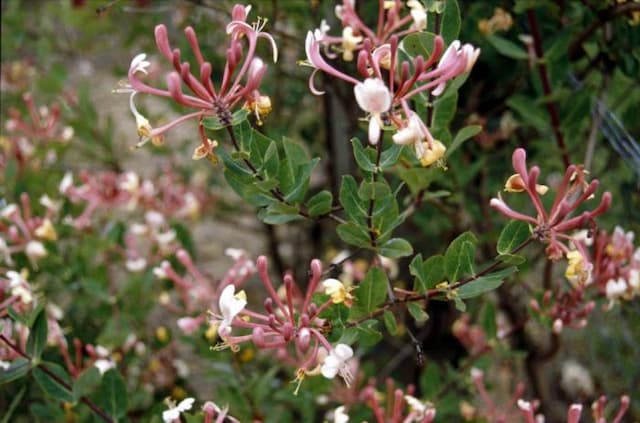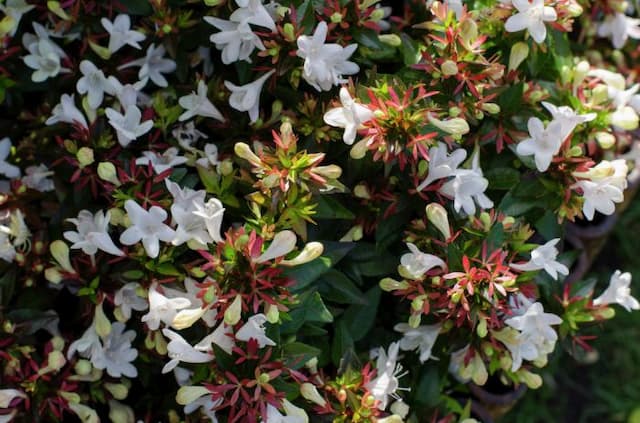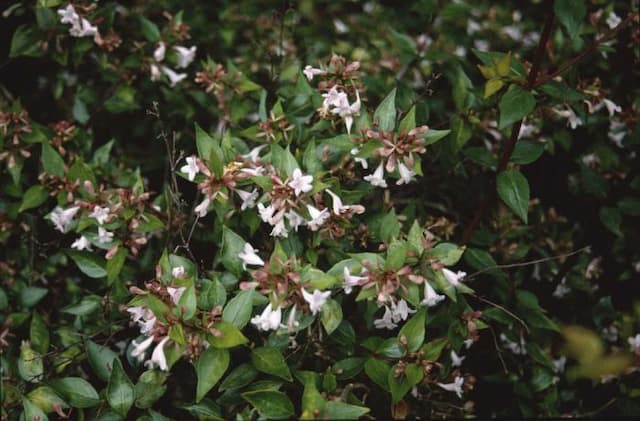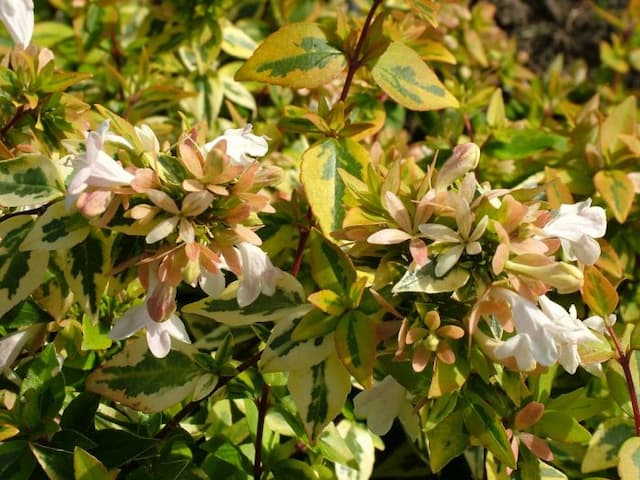Wine and Roses Weigela Weigela florida 'Alexandra' (PBR)

ABOUT
Weigela florida 'Alexandra', commonly known as wine and roses weigela, is a deciduous shrub known for its striking appearance. This plant is characterized by its rich burgundy-purple leaves that maintain their color intensity throughout the growing season. In spring, the foliage is further complemented by the profusion of trumpet-shaped flowers. These blossoms are a deep, rosy-pink hue and attract a variety of pollinators, including hummingbirds. The branches of wine and roses weigela arch gracefully and are densely packed with leaves, creating a lush and full look. The flowers are arranged in clusters, making a visually striking contrast against the dark foliage. This combination of dark leaves and bright flowers gives the wine and roses weigela a dramatic and sophisticated aesthetic that can enhance the visual appeal of any garden setting. After the initial spring bloom, the wine and roses weigela may sporadically produce flowers throughout the summer, giving it extended interest in the landscape. Its leaves sometimes develop a greenish tinge as the seasons progress, but they generally retain their deep coloring up until the leaves drop in the fall.
About this plant
 Names
NamesFamily
Caprifoliaceae
Synonyms
Wine And Roses Weigela, Midnight Wine, Alexandra Weigela
Common names
Weigela florida 'Alexandra' (PBR).
 Toxicity
ToxicityTo humans
Weigela is generally considered non-toxic to humans. There is no significant risk of poisoning from ingesting parts of the Weigela plant, and there are typically no adverse symptoms that would arise from accidental ingestion in normal garden scenarios.
To pets
Weigela is not known to be toxic to pets. If a pet ingests parts of the Weigela plant, it is unlikely to suffer from poisoning or show symptoms of toxicity. However, as with the ingestion of any non-food plant material by pets, gastrointestinal upset may occur in some cases.
 Characteristics
CharacteristicsLife cycle
Perennials
Foliage type
Deciduous
Color of leaves
Purple
Flower color
Pink
Height
4-5 feet (1.2-1.5 meters)
Spread
4-5 feet (1.2-1.5 meters)
Plant type
Shrub
Hardiness zones
4-8
Native area
East Asia
Benefits
 General Benefits
General Benefits- Attractive Flowers: Weigela 'Alexandra' produces abundant, trumpet-shaped pink flowers that bloom profusely in late spring and early summer.
- Reblooming: This variety may have a second, lighter flush of flowers later in the season.
- Foliage Interest: The plant has dark burgundy-purple foliage that provides visual interest throughout the growing season.
- Habitat for Wildlife: The flowers are attractive to hummingbirds, butterflies, and other pollinators, providing an important source of nectar.
- Architectural Structure: The arching branches of the Weigela 'Alexandra' offer a graceful, spreading form that can add structure to garden landscapes.
- Easy to Grow: This shrub is considered easy to care for, requiring minimal maintenance and adaptable to a variety of soils.
- Drought Tolerance: Once established, Weigela 'Alexandra' is fairly drought-resistant, making it suitable for gardens with less frequent watering.
- Decoration: Its colorful presence makes it an excellent choice for ornamental use in mixed borders, as a specimen plant, or for mass plantings.
- Privacy Screening: When planted in groups or rows, Weigela 'Alexandra' can provide a dense screen that enhances privacy.
- Seasonal Interest: With its spring flowers and autumn foliage color, it contributes multi-seasonal interest to gardens and landscapes.
- Versatility: Suitable for a wide range of landscaping uses, including foundation plantings, hedges, or as part of a shrub border.
 Medical Properties
Medical PropertiesThis plant is not used for medical purposes.
 Air-purifying Qualities
Air-purifying QualitiesThis plant is not specifically known for air purifying qualities.
 Other Uses
Other Uses- Photography and Art: Weigela florida 'Alexandra', with its striking foliage and flowers, can be used as a subject for photography and botanical illustrations to capture the charm of gardens and nature.
- Educational Tools: In educational gardens or botanical displays, Weigela can be used to demonstrate plant growth habits, seasonal changes, and pollination by attracting bees and butterflies for observational studies.
- Sound Barrier: When planted in dense hedges along property lines or roads, Weigela can act as a sound barrier, reducing noise pollution from traffic or neighboring properties.
- Privacy Screening: The bushy nature and height of Weigela make it ideal for creating private nooks in gardens or for screening off unsightly areas like utility boxes or compost piles.
- Perfumery: While not a common source for perfumes, the subtle fragrance of Weigela flowers could inspire unique scents in artisanal or homemade perfume blends.
- Crafting: Branches with leaves and flowers can be used in floral arrangements or woven into decorative wreaths and garlands for events or home decor.
- Fabric Dye: The flowers and leaves of Weigela, particularly the darker cultivars, may be used in the natural dyeing process to impart color to fabrics and yarns.
- Culinary Decoration: Although not edible, the flowers can be used temporarily to garnish or decorate plates and platters for special occasions, giving an elegant touch to culinary presentations.
- Seasonal Celebrations: Weigela can be incorporated into seasonal festivities by using its branches and flowers as part of May Day baskets or other spring celebrations.
- Wedding Ceremonies: Due to their aesthetic appeal, branches of Weigela can be used to create natural and romantic settings for wedding ceremonies, such as forming part of the arch or decorating the aisle.
Interesting Facts
 Feng Shui
Feng ShuiThe plant Weigela is not used in Feng Shui practice.
 Zodiac Sign Compitability
Zodiac Sign CompitabilityThe plant Weigela is not used in astrology practice.
 Plant Symbolism
Plant Symbolism- Gratitude and Admiration: With its lush blooms, Weigela is often seen as a symbol of gratitude and admiration, making it a perfect gift to show appreciation.
- Prosperity: The abundant springtime flowers can signify prosperity and the hope for growth in various aspects of life.
- Romantic Love: The Weigela's bright and attractive blooms are sometimes used to represent the beauty and passion of romantic love.
- Endurance: Being a hardy shrub that comes back year after year, it symbolizes endurance and the ability to withstand hardships.
 Water
WaterWine and Roses Weigela should be watered deeply, ensuring moisture reaches the root zone, particularly during the first growing season to establish a deep, extensive root system. Once established, it requires less frequent watering but should not be allowed to dry out completely. Aim to provide about 1 inch of water per week, either from rainfall or supplemental watering. During particularly hot or dry periods, check moisture levels and water as needed, possibly increasing to twice per week, providing about 2 gallons per plant at each watering.
 Light
LightWine and Roses Weigela thrives in full sun to partial shade, with at least 6 hours of direct sunlight each day being ideal for the best flowering and foliage color. Position it in a spot where it can receive unfiltered morning light and some afternoon shade, especially in hotter climates, to protect it from the intense late-day sun.
 Temperature
TemperatureWine and Roses Weigela is tolerant of a wide range of temperatures and can survive in conditions as low as 5°F in winter and as high as 95°F in summer. However, the ideal temperature range for optimal growth and flowering is between 55°F and 75°F. Ensure it's planted in an area that avoids harsh winter winds to minimize temperature stress.
 Pruning
PruningPrune Wine and Roses Weigela immediately after it finishes blooming to encourage new growth and subsequent flowering. This usually means a late spring or early summer pruning, removing any dead or crossed branches to maintain an attractive shape. Pruning out up to one-third of the oldest stems can rejuvenate the plant and enhance blooming for the following year.
 Cleaning
CleaningAs needed
 Soil
SoilThe best soil mix for Weigela, commonly known as "Wine & Roses," is a well-draining, fertile loam with a pH of 5.5 to 7.5. Amend garden soil with compost or peat moss to improve drainage and nutrient content.
 Repotting
RepottingWine & Roses Weigela generally does not require regular repotting as it is a shrub best grown outdoors; if planted in containers, repot every 3-4 years or when rootbound.
 Humidity & Misting
Humidity & MistingWine & Roses Weigela is adaptable to a wide range of humidity levels and does not require specific humidity conditions for optimal growth.
 Suitable locations
Suitable locationsIndoor
Grow Wine & Roses Weigela in a large pot with ample light indoor.
Outdoor
Plant Wine & Roses Weigela in full sun and well-draining soil outdoor.
Hardiness zone
4-8 USDA
 Life cycle
Life cycleWine & Roses Weigela, botanical name Weigela florida 'Alexandra' (PBR), begins its life cycle as a dormant cut or seed which, once planted, germinates and sprouts into a seedling. The plant enters a vegetative stage as it establishes a root system and grows stems and leaves, becoming a young plant. It matures over the years, developing a more complex root structure, woody stems, and a fuller spread of foliage. Flowering typically occurs in late spring to early summer when conditions are favorable, showcasing pink to red trumpet-shaped flowers that attract pollinators such as bees and hummingbirds. After pollination, the plant may produce small insignificant seed capsules, although many cultivated varieties are grown from cuttings rather than seeds. As it ages, the Wine & Roses Weigela enters a period of senescence before eventually dying, but it can live for many years, with proper care, before reaching this final stage.
 Propogation
PropogationPropogation time
Spring-Early Summer
The most popular method of propagating the Weigela florida 'Alexandra', commonly known as Wine and Roses Weigela, is by softwood cuttings. This is typically done in late spring or early summer when new growth is still flexible but not too tender. Gardeners cut a 4-6 inch (10-15 cm) section of the plant's stem that includes at least two sets of leaves. The lower leaves are then removed, and the cut end is dipped in rooting hormone to encourage growth. The cutting should be planted in a well-draining soil mix and kept moist under a light shade until roots develop, which usually takes a few weeks to a month. During this period, high humidity can improve the rooting process, so some form of covering may be used to retain moisture.









